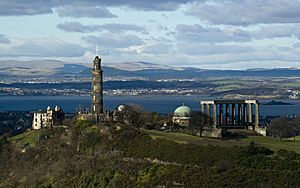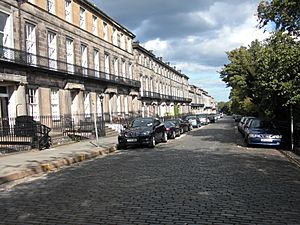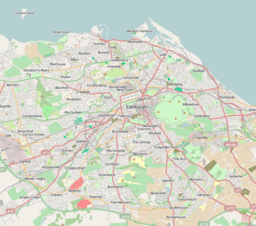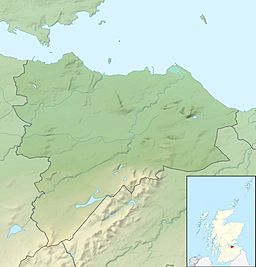Calton Hill facts for kids
Quick facts for kids Calton Hill |
|
|---|---|
| Caltoun, Caldoun | |

A view of Calton Hill with some of its many monuments, seen from the Salisbury Crags
|
|
| Highest point | |
| Elevation | 103 m (338 ft) |
| Prominence | 46 m (151 ft) |
| Naming | |
| Native name | Error {{native name}}: an IETF language tag as parameter {{{1}}} is required (help) |
| Geography | |
Calton Hill is a well-known hill in central Edinburgh, Scotland. It sits just east of Princes Street, a main shopping street. This hill is part of Edinburgh's UNESCO World Heritage Site. Many photos and paintings of Edinburgh feature the amazing views from, or of, Calton Hill.
Calton Hill is home to many important buildings and monuments. You can find the National Monument, the Nelson Monument, and the Dugald Stewart Monument here. The old Royal High School and the City Observatory are also on the hill. The Scottish Government has its main offices at St Andrew's House on the hill's southern side. The Scottish Parliament Building and Holyrood Palace are also nearby.
Contents
What's in a Name?
Calton Hill has had a few names over time. In 1456, it was called "Cragingalt" in official documents. This name might have come from an old language meaning "crag on the hill" or "wooded hillside."
Later, around 1591, people called the area "Caldtoun" or "Cold town." This name was common until about 1700. The names "Calton" and "Caltonhill" started appearing after 1725. This was when the western part of the hill was sold to the city of Edinburgh.
A Look Back in Time
Calton Hill has a long and interesting history. It might have been home to an ancient hillfort long ago. In 1456, King James II gave the land between Calton Hill and Greenside to the people of Edinburgh. They used this area for sports and military training, like archery.
This natural open space was also used for plays. An early Scottish play, "Ane Pleasant Satyre of the Thrie Estaitis," was performed here. In 1518, a group of monks called the Carmelite Friars built a small monastery nearby.
After 1560, when monasteries were no longer used, the building on Calton Hill became a hospital for people with leprosy in 1591. The rules were very strict. In 2009, ten skeletons were found during roadworks. Experts believe these might be connected to the old hospital.
For a long time, the Logan family owned the Calton area. Later, it passed to the Elphinstone family. In 1725, Edinburgh bought the western part of Calton Hill. The eastern part belonged to a charity called Heriot's Trust. Calton officially became part of Edinburgh in 1856.
In 1631, a group called The Society of the Incorporated Trades of Calton was formed. This group allowed any skilled worker to join, as long as their work was good. This helped trade and business grow in the area.
The old village of Calton was at the bottom of the hill. Many of its old buildings were taken down in the 1800s and 1970s.
Even though Calton was close to Edinburgh, its people went to church in a different town, Leith. In 1718, the Society bought land for a burial ground. This became known as Old Calton Burial Ground. A steep road was built up the hill to reach it. Some houses from the 1760s still stand near the top of this road.
In 1787, an artist named Robert Barker was inspired by the views from Calton Hill. He created the world's first panorama. This was a huge 360-degree painting showing Edinburgh from the top of the hill.
Famous Buildings and Monuments
Calton Hill is famous for its many monuments and buildings.
Old Calton Burial Ground
The Old Calton Burial Ground is on the southwestern side of the hill. The famous philosopher David Hume is buried here. His tomb is simple, just showing the years he was born and died. The Political Martyrs' Monument is also in this burial ground. It remembers five people who fought for political change in the late 1700s.
Calton Jail and St. Andrew's House
Calton Hill was once the site of the well-known Calton Jail. This prison complex included different sections for debtors and felons. The prisons were taken down in 1930. Today, St Andrew's House stands on this site. This building is where many of Scotland's government workers have their offices. The old Governor's House from the prison still stands. You can also see parts of the prison walls on the south side of St. Andrew's House.
Regent Bridge and Terraces
The eastern end of the beautiful Regent Bridge is built into the side of the hill. This bridge crosses a deep valley to connect the hill with Princes Street. The engineer who built Regent Bridge in 1815 was Robert Stevenson. He was the grandfather of the famous author Robert Louis Stevenson.

A famous Scottish architect, William Henry Playfair, designed the elegant streets that go around the hill. These streets are Royal Terrace, Carlton Terrace, and Regent Terrace. The largest houses are on Royal Terrace. These streets were built starting in 1819. The gardens that cover much of the hill's top are private and managed by a local group.
Many of the buildings on these terraces are homes. However, Royal Terrace also has several hotels. The United States Consulate is located on Regent Terrace. Royal Terrace was popular with shipowners and traders because of its views over Leith and the Firth of Forth. For a while in the 1800s, it was even called "Whisky Row."
Some famous people have lived on Regent Terrace. Louis-Antoine, Duke of Angoulême, a French royal, lived there in the 1830s with his wife. The painter Francis Cadell, a Scottish Colourist, also lived on Regent Terrace.
The Scottish National Monument
Playfair also designed many of the large monuments on top of the hill. The most famous is the Scottish National Monument. This monument was meant to look like the Parthenon in Greece. It was planned to remember Scottish soldiers who died in the Napoleonic wars. Building started in 1826 but stopped in 1829 because there wasn't enough money. It has never been finished. For many years, people called it "Scotland's Disgrace." But now, it is accepted as it is.
Other Structures
The Royal High School was built on the southern slopes of the hill in 1829. It is a well-known part of Edinburgh's skyline. In the 1840s, a tunnel was built through the hill under the High School. This tunnel carried train tracks from Waverley Station eastward.
"Rock House," which overlooks Waterloo Place, was the home of Robert Adamson. He worked with David Octavius Hill to create early photographs in Scotland in the 1840s. They took many pictures in their house and garden.
At the bottom of the southern steps, there is a memorial to three Scottish singers from the 1800s: John Wilson, John Templeton, and David Kennedy.
Fun Events on the Hill
Calton Hill is a popular place for many events throughout the year. The biggest event is the Beltane Fire Festival, held every year on April 30th. Over 12,000 people attend this exciting festival. The Dussehra Hindu Festival also takes place on Calton Hill in early October. The Samhuinn Fire festival happens at the end of October.
Calton Hill has also been used as a filming location for movies. You can see it in films like "Sunshine on Leith," "Death Defying Acts," and "Greyfriars Bobby."
Friends of Calton Hill
The Friends of Calton Hill is a group of local volunteers. They help manage and improve the park resources on the hill. This group was started in 2023.
|









